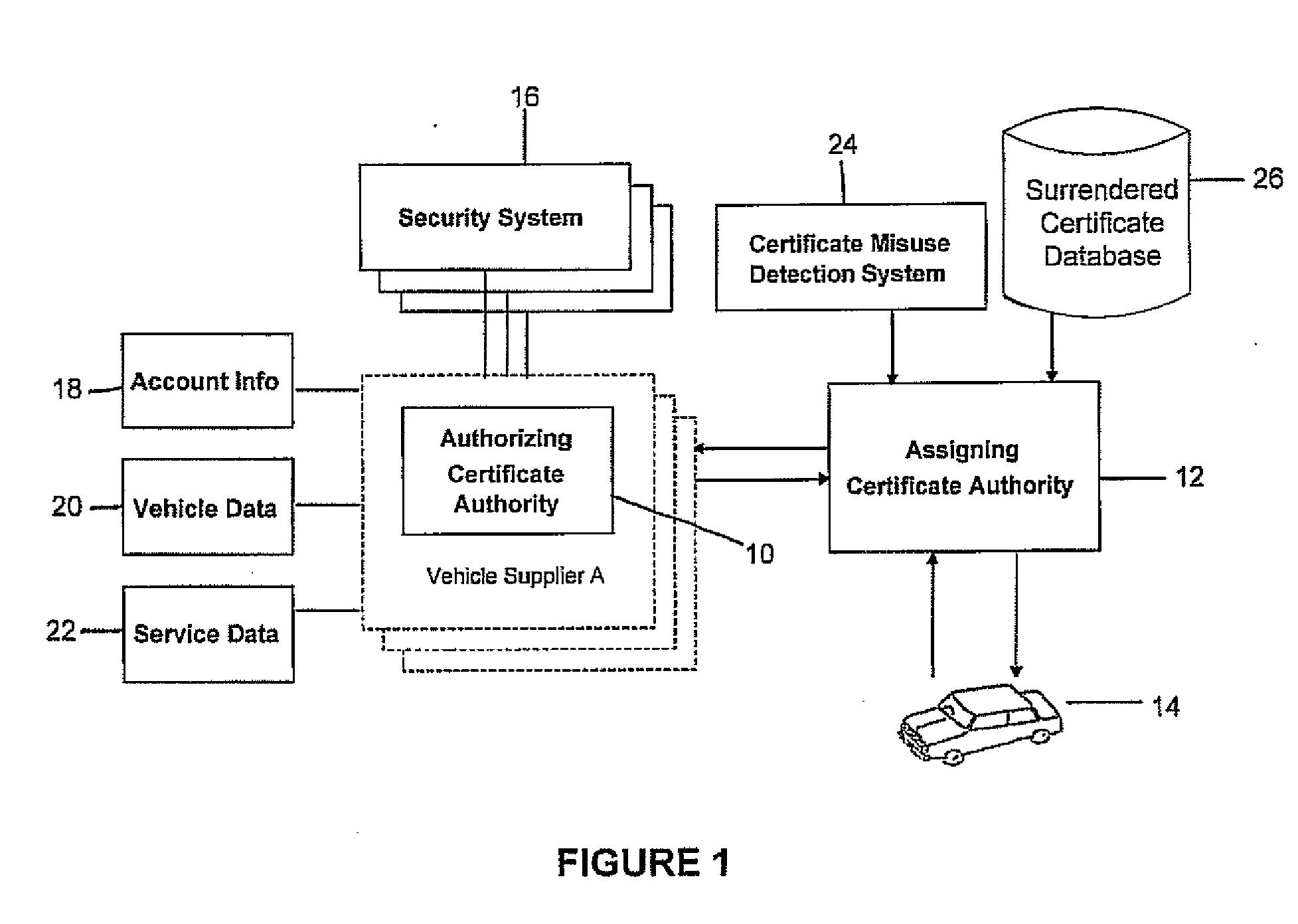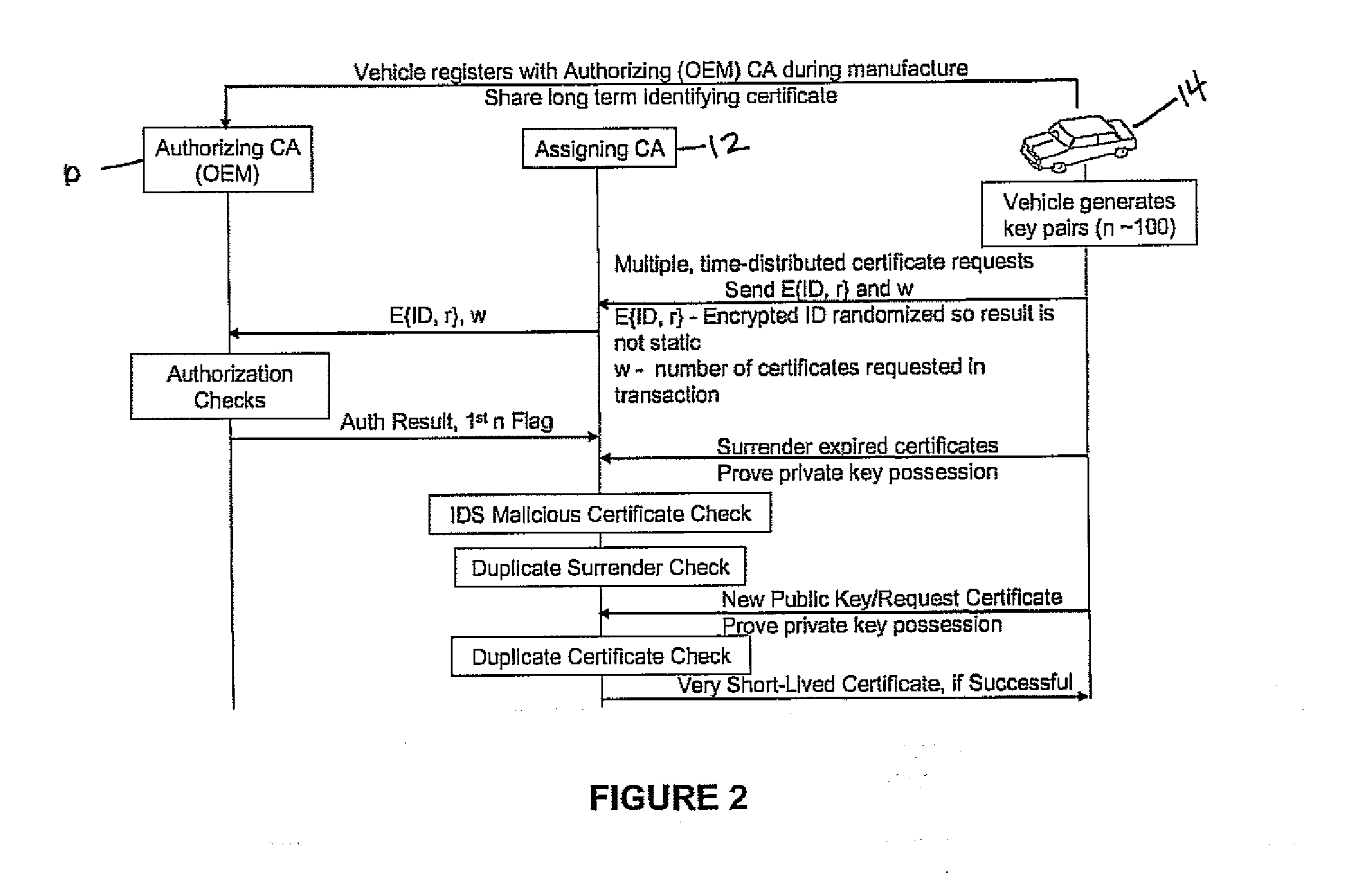Defining a method for managing anonymous certificates for vehicle communications networks, such as the Vehicle Infrastructure Integration (VII)
system, is a very difficult, complex, and multi-faceted technical challenge.
A significant part of this challenge is to protect vehicle privacy, i.e., secure vehicle communications so that the source remains anonymous and messages cannot be linked to one another.
Traditional certificate management techniques are unacceptable because they use certificates that can readily identify the user and do not preserve vehicle privacy.
No anonymous certificate method proposed to date has completely satisfied all design goals.
However, the balance among
scalability, privacy, and performance in this category is limited.
However, certificate
revocation and replacement methods in the basic combinatorial certificate schemes have several crucial limitations that need to be overcome.
First, they cannot support a moderate to high number of attackers.
Second, they will result in unpredictable and uncontrollable probability distributions of certificates among vehicles, resulting in unpredictable and uncontrollable system
scalability and performance.
For example, they use a fixed rekey threshold to determine which vehicles should no longer be allowed to receive new anonymous certificates, but do not provide a method for decrementing or resetting the rekey counters.
Combinatorial certificate management schemes exhibit a fundamental
weakness, known as the “one affects many” problem.
The “one affects many” problem refers an inherent attribute of shared certificate schemes where a
threat to a certificate held by one vehicle is amplified by the sharing of keys and affects a large number of vehicles.
1. A large number of innocent vehicles are impacted when a certificate is revoked
3. Vulnerable to “Large Scale” Attacks
4. Difficult to identify the source of malicious messages
The sharing of a common
pool of keys forms the basis of vehicle
anonymity in the combinatorial scheme, but it is also the root of the “one affects many” problem.
In essence, a large number of innocent vehicles potentially become “collateral damage” from the
revocation of a single certificate.
If an innocent vehicle becomes the unfortunate victim of a large number of certificate revocations, the vehicle may trigger the
enforcement of a re-
keying quota.
Although the intent of the quota is to limit re-
keying for misbehaving vehicles, some innocent vehicles will unnecessarily trigger disciplinary actions as “false positives.” When the effect is measured as the mean time to
vehicle inspection, the combinatorial scheme has been shown to be very sensitive to the number of misbehaving vehicles.
In a system with 200,000,000 vehicles, this results in an undesirable inspection rate of five to eight million vehicles per month.
Any
attack that can
exploit the “one affects many”
weakness in the combinatorial scheme is a serious concern.
One particularly damaging
attack that efficiently exploits this
weakness is the “Large Scale”
attack.
In a “Large Scale” attack, a large number of certificates are compromised by, for instance, extracting the key information from vehicles.
Since the shared
pool of certificates is relatively small with respect to the number of vehicles in the system, an attacker need only compromise a relatively small number of vehicles to
impact a very large percentage of all vehicles.
The sharing of certificates, while providing the benefit of
anonymity, also makes it difficult to identify misbehaving vehicles.
Second, each malicious message must be traced to a vehicle source.
Third, the vehicle source must be disabled from generating messages that will be interpreted as legitimate in the vehicle network system.
Due to the nature of vehicle communication, its non-transactional behavior, and the size of a nationwide vehicle network system, the first step of detecting malicious messages and particularly, those with valid signatures, is an extremely difficult and challenging task.
Depending upon the message context, it may be very difficult to delineate malicious message from a valid message.
Some types of malicious behavior may also be beyond the system's ability to detect it.
There is also a certain amount of
delay in detecting malicious behavior.
Some malicious messages may not be observed because it may be impractical to inspect all vehicle messages.
The use of thresholds to tally malicious events before taking an action inherently introduces
delay.
In shared certificate schemes, such as the combinatorial scheme, the second step of identifying the vehicle source of a malicious message, which relies upon the consistency and accuracy of the first, is also a difficult and complicated task.
But this process could require many rounds to identify the misbehaving vehicle.
There are several concerns with multi-step approaches:Unreliable detection of malicious behavior will
delay or potentially undermine the process to identify a misbehaving vehicle.Each of the multiple rounds of re-
keying needed to identify a misbehaving vehicle provides an opportunity for the attacker to change its mode of attack and potentially evade discovery.Each round of re-keying introduces additional delay and extends the period of time that an attacker can continue operating.Multiple, simultaneous attacks make identification of misbehaving vehicles more difficult and increase the probability that an innocent vehicle will be identified as a misbehaving vehicle.
Finally, another undesirable aspect of the combinatorial scheme is the
high probability that all vehicles in a given area will share no common certificates.
When combined with the use of a small number of certificates per vehicle, it is not too difficult to begin linking messages to a particular vehicle source and tracking a vehicle, thereby violating its privacy and
anonymity.
The prior art combinatorial scheme has several drawbacks and limitations with preserving privacy, exhibiting strong sensitivity to the number of attackers, and being able to quickly and accurately remove misbehaving vehicles, which are inherent from the sharing of certificates.
Anonymous
Certificate: A certificate associated with a public-private key pair that, when used by vehicles, will not enable the identification and tracking of vehicles.
Anonymous private keys are highly confidential and any compromise of an anonymous key can threaten the integrity of the VII system.
It is computationally infeasible to derive a private key from a public key.
 Login to View More
Login to View More  Login to View More
Login to View More 


